NAL-301
N-ACETYLNEURAMINIC ACID ALDOLASE from Microorganism

PREPARATION and SPECIFICATION
| Appearance | Yellowish amorphous powder, lyophilized | |
|---|---|---|
| Activity | GradeⅢ 15U/mg-solid or more (30U/mg-protein or more) (containing approx. 30% of stabilizers) |
|
| Contaminants | Catalase | ≤1.0% |
| NADH oxidase | ≤1.0×10-3% | |
| Stabilizers | Mannitol, EDTA | |
PROPERTIES
| Stability | Stable at 20℃ for at least one year (Fig.1) |
|---|---|
| Molecular weight | approx. 98,000 |
| Isoelectric point | 4.6±0.1 |
| Michaelis constant | 2.5×10-3M (N-Acetylneuraminic acid) |
| Structure | 3 subunits (approx. 35,000) per enzyme molecule |
| Inhibitors | p-Chloromercuribenzoate, SDS, Hg++, Ag+ |
| Optimum pH | 7.58.0 (Fig.3) |
| Optimum temperature | 70℃ (Fig.4) |
| pH Stability | pH 6.09.0 (10℃, 25hr) (Fig.5) |
| Thermal stability | below 65℃ (pH 7.5, 30min) (Fig.6) |
| Effect of various chemicals | (Table 1) |
APPLICATIONS
This enzyme is useful for enzymatic determination of N-acetylneuraminic acid and sialic acid when coupled with the related enzymes in clinical analysis. 57)
For industrial use, this enzyme is useful for enzymatic synthesis of sialic acid. 89)
ASSAY
Principle

The disappearance of NADH is measured at 340 nm by spectrophotometry.
Unit definition
One unit causes the oxidation of one micromole of NADH per minute under the conditions described below.
Method
Reagents
| A. NANA solution | 50mM[Dissolve 309mg of N-acetylneuraminic acid (MW=309) in approx. 15ml of 50mM K-phosphate buffer, pH 7.5 and, after adjusting the pH to 7.5 with 1N KOH, fill up to 20ml with the same buffer.] (Stable for at least one week if stored at 0 5℃) |
|---|---|
| B. LDH solution | approx. 50U/ml[Dilute pig heart lactate dehydrogenase (Toyobo GradeⅡ, ammonium sulfate suspension) to a concentration of approx. 50U/ml with ice-cold 50mM K-phosphate buffer, pH 7.5] (Should be freshly prepared) |
| C. NADH solution | 1.0mM[Dissolve 7.6mg of NADH・Na2・3H2O (MW=763) in 10ml of 50mM K-phosphate buffer, pH 7.5] (Should be freshly prepared) |
| D. Buffer solution | 50mM K-phosphate buffer, pH 7.5 |
| E. Enzyme diluent | 50mM K-phosphate buffer, pH 7.5 containing 0.2% BSA |
Procedure
1.Prepare the following reaction mixture in a cuvette (d=1.0cm) and equilibrate at 37℃ for about 5 minutes.
| 1.0ml | Substrate solution | (A) |
|---|---|---|
| 0.5ml | LDH solution | (B) |
| 0.5ml | NADH solution | (C) |
| 0.4ml | Buffer solution | (D) |
| Concentration in assay mixture | |
|---|---|
| K-Phosphate buffer | 50 mM |
| NANA | 20 mM |
| NADH | 0.2mM |
| LDH | ca.10 U/ml |
2.Add 0.1ml of the enzyme solution* and mix by gentle inversion.
3.Record the decrease in optical density at 340nm against water for 3 to 4 minutes in spectrophotometer thermostated at 37℃, and calculate the ΔOD per minute from the initial linear portion of the curve (ΔOD test). At the same time, measure the blank rate (ΔOD blank) using the same method the test except that the enzyme diluent (E) is added instead of the enzyme solution.
*Dissolve the enzyme preparation in ice-cold enzyme diluent (E) and dilute to 0.10.3U/ml with the same buffer, immediately before assay.
Calculation
Activity can be calculated by using the following formula :
Volume activity (U/ml) =
-
ΔOD/min (ΔOD testΔOD blank)×Vt×df
6.22×1.0×Vs
= ΔOD/min×4.02×df
Weight activity (U/mg) = (U/ml)×1/C
| Vt | : Total volume (2.5ml) |
| Vs | : Sample vol ume (0.1ml) |
| 6.22 | : Millimolar extinction coefficient of NADH (cm2/micromole) |
| 1.0 | : Light path length (cm) |
| df | : Dilution factor |
| C | : Enzyme concentration in dissolution (c mg/ml) |
REFERENCES
1)D.G.Comb and S.Roseman; J.Biol.Chem., 235, 2529 (1960).
2)D.G.Comb and S.Roseman; Meth.Enzymol., 5, 391 (1960).
3)S.B.Arden, W.Chang and L.Barksdale; J.Bacteriol., 112, 1260 (1972).
4)Y.Uchida, Y.Tsukada and T.Sugimori; Agric.Biol.Chem., 49, 181 (1985).
5)P.Burunetti, A.Swanson and S.Roseman; Meth.Enzymol., 6, 465 (1963).
6)K.Taniuchi, Y.Miyamoto, Y.Uchida, K.Chifu, M.Mukai, N.Yamaguchi, Y.Tsukada, T.Sugimori, K.Doi and S.Baba; J.Med.Technol. (Japanese), 7, 403 (1979).
7)K.Sugahara, K.Sugimoto, O.Nomura and T.Usui; Clin.Chim.Acta, 108, 493 (1980).
8)Mahn-Joo Kim,William J.Hennen,H.Marcel Sweers and Chi-Huey Wong; J.Am.Chem.Soc.,110, 6481 (1988).
9)Ethan S.Simon,Mark D.Bednarski,and George M.Whitesides; J.Am.Chem.Soc.,110, 7159 (1988).
Table 1. Effect of Various Chemicals on N-Acetylneuraminic acid aldolase
[The enzyme dissolved in 0.1M Tris-HCI buffer, pH7.5 (5U/ml) was incubated at 30℃ for 1hr.]
-
Chemical Concn.(mM) Residual activity(%) None - 100 Metal salt 2.0 MgCl2 107 CaCl2 87 Ba(OAc)2 95 FeCl3 89 CoCl2 93 MnCl2 98 ZnSO4 92 NiCl2 99 CuSO4 64 Pb(OAc)2 87 AgNO3 0 HgCl2 0 -
Chemical Concn.(mM) Residual activity(%) PCMB 2.0 0 NEM 2.0 103 NaF 2.0 100 NaN3 20 100 EDTA 5.0 95 o-Phenanthroline 2.0 100 α,α′-Dipyridyl 2.0 101 Borate 50 86 Triton X-100 0.10% 109 Na-cholate 0.10% 95 SDS 0.10% 0 Tween 40 0.10% 96 Span 85 0.10% 93
-
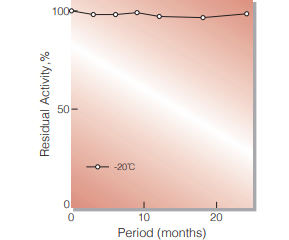
Fig.1. Stability (Powder form)
(kept under dry conditions)
-
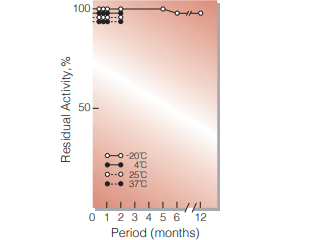
Fig.2. Stability (Powder form)
(kept under dry conditions)
-
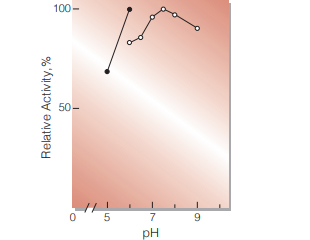
Fig.3. pH-Activity
37℃, 5min-reaction in 50mM buffer solution : pH5.0-6.0, acetate; pH6.0- 9.0, K-phosphate; The enzyme activity was assayed by the 2,4-dinitroplenylhydradine method.
-
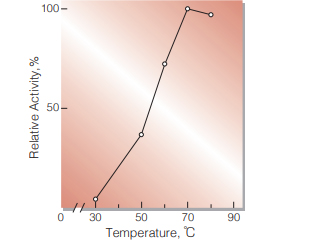
Fig.4. Temperature activity
5min-reaction in 50mM K-phosphate buffer pH7.5, The enzyme activity was assayed by the 2,4-dinitroplenylhydradine method.
-
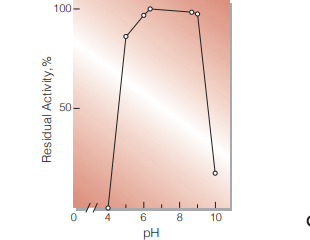
Fig.5. pH-Stability
10℃, 25hr-treatment with 50mM buffer solution : pH4.0-6.0, acetate; pH6.0-9.0, K-phosphate ; pH9.0-10.0, borate.
-
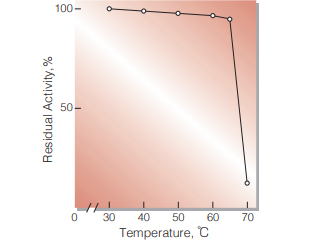
Fig.6. Thermal stability
30min-treatment with 50mM K-phosphate buffer, pH7.5, enzyme concentration.: 20U/ml
活性測定法(Japanese)
1. 原理

NADHの消失量を340nmの吸光度の変化で測定する。
2.定義
下記条件で1分間に1マイクロモルのNADHが酸化される酵素量を1単位(U)とする。
3.試薬
- 50mM NANA溶液 〔309㎎のN-アセチルノイ ラミン酸(MW=309)を約15mlの50mM K-リン 酸緩衝液,pH7.5に溶解し,1N KOHでpHを 7.5に調整後,同緩衝液で20mlとする〕(05 ℃保存で1週間は使用可能)
- LDH溶液〔ブタ心臓LDH(東洋紡製GradeⅡ, 硫安懸濁液)を50mM K-リン酸緩衝液,pH7.5 で,約50U/mlに希釈する〕(用時調製)
- 1.0mM NADH溶液〔7.6㎎のNADH・Na2・ 3H2O (MW=763)を10mlの50mM K-リン酸緩 衝液,pH7.5に溶解する〕(用時調製)
- 50mM K-リン酸緩衝液,pH7.5 酵素溶液:酵素標品を予め氷冷した0.2%のBSAを 含む50mM K-リン酸緩衝液,pH7.5 (D) で溶解し,分析直前に同緩衝液で0.1 0.3U/mlに希釈する。
4.手順
1.下記反応混液をキュベット(d=1.0cm)に調製し,37℃で約5分間予備加温する。
| 1.0ml | 基質溶液 | (A) |
| 0.5ml | LDH溶液 | (B) |
| 0.5ml | NADH溶液 | (C) |
| 0.4ml | K-リン酸緩衝液 | (D) |
2.酵素溶液0.1mlを添加し,ゆるやかに混和後,水を対照に37℃に制御された分光光度計で340nmの吸光度変化を34分間記録し,その初期直線部分から1分間当りの吸光度変化を求める(ΔODtest)。
3.盲検は反応混液①に酵素溶液の代りに酵素希釈液(0.2%BSAを含む50mM K-リン酸緩衝液,pH7.5)0.1mlを加え,上記同様に操作を行って,1分間当りの吸光度変化を求める(ΔOD blank)。
5.計算式
U/ml =
-
ΔOD/min (ΔOD testΔOD blank)×2.5ml×希釈倍率
6.22×1.0×0.1(ml)
| = ΔOD/min×4.02×希釈倍率 | |
| U/mg | = U/ml×1 / C |
| 6.22 | : NADHのミリモル分子吸光係数 (cm2/micromole) |
| 1.0 | : 光路長(cm) |
| C | : 溶解時の酵素濃度(c ㎎/ml) |
CONTACT
お問い合わせ-
各種製品に関するご質問・ご相談はこちらよりお問い合わせください。
